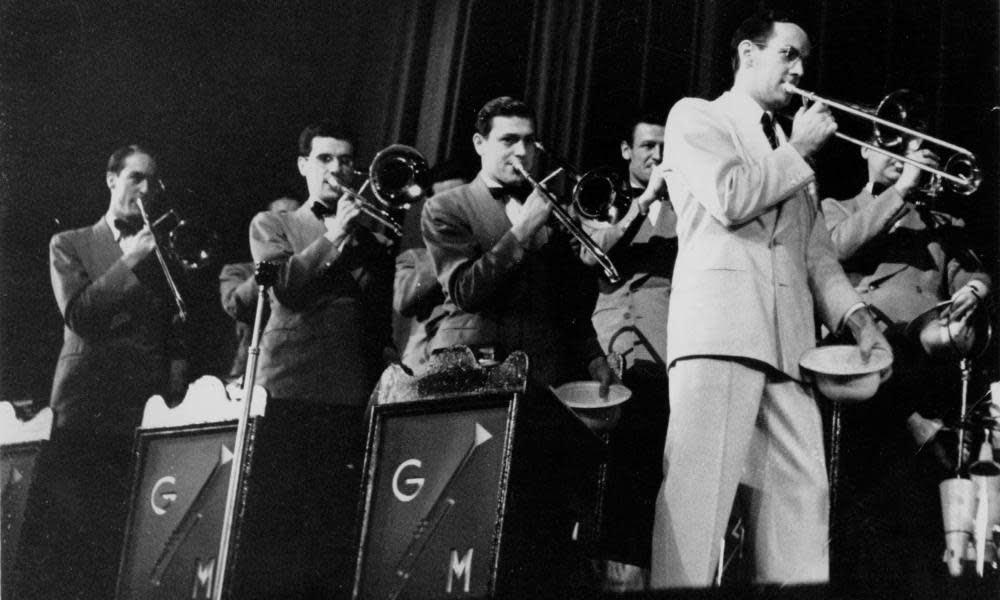Glenn Miller book clears RAF of accidentally killing band leader

The death of Glenn Miller has been one of the enduring unsolved mysteries of the second world war. The US musician’s aircraft vanished over the Channel without trace in 1944 after leaving a British airbase for France. The disappearance of the hottest big-band leader of the era has provoked numerous theories, some wild, with a long-held claim that his plane was brought down by RAF Lancasters jettisoning their bombs over the English Channel.
But that latter theory has been challenged by new research. Dennis Spragg, a historian and pilot, has analysed flight data and discovered that the Lancasters dumped their bombs 90 minutes before Miller’s plane went down. “For several decades, the Lancaster claim has become perhaps the most accepted scenario about what happened to Miller’s plane – but it is not true,” he said.
The evidence has led him to conclude that “the RAF did not accidentally kill Major Glenn Miller”.
Spragg is senior consultant at the Glenn Miller archive at the University of Colorado. He will publish his latest research in his forthcoming book, titled Glenn Miller Declassified, to be published by Potomac Books, University of Nebraska Press on 1 September. “The definitive circumstances of the crash, investigation and the consequences for American officers are all new, and have never been known or published,” he said.
On 15 December 1944, Miller boarded the Eighth Air Force Service Command “Norseman” aircraft at the RAF Twinwood aerodrome, Clapham, Bedfordshire. It was heading for Ninth Air Force aerodrome, Vélizy-Villacoublay in France. The band leader and jazz trombonist, whose hits included Pennsylvania 6-5000 and In the Mood, was on his way to organise a Christmas concert for the troops in liberated Paris. He was regarded as one of the war’s greatest morale boosters.
After his plane’s disappearance, the Eighth Air Force launched a search and investigation, eventually determining that the likely causes were pilot disorientation, mechanical failure and/or the weather. No trace of the aircraft or its occupants has ever been found and he remains missing in action. Speculation about his demise has included the theory that he was captured and tortured to death by the Nazis.
In 2001 a television documentary presented evidence that on 15 December a fleet of 139 Lancaster bombers returning from an aborted mission to Germany dumped their bombs above the Channel and on to Miller’s plane. It included a claim by a navigator on one of the Lancasters that he saw a “kite” – or small aircraft – crash into the sea below as his Lancaster bomb aimer jettisoned a 4,000lb “cookie” over the Channel jettison area.
Spragg dismisses the claim: “The lowest altitude any Lancaster reported for a jettison was 5,000ft. The recommended jettison altitude was 6,000ft. One mile is 5,280ft. A Norseman flying almost one mile below would have looked like an indistinct flyspeck.”
He also finds it inconceivable that a Lancaster aircrew did not immediately radio a report about an aircraft in distress: “It was the obligation of airmen to report friendly aircraft in distress over Allied territory.” The Lancaster pilot and crew did not file a report of any incident to squadron intelligence when they returned, he said.
He added that the new research establishes “beyond any reasonable doubt” that Miller’s plane was flown by an experienced pilot and was in proper working order, but crashed into the Channel due to mechanical failure caused by pilot error and weather. “He was flying too low – below 2,000 ft – and he exposed aircraft to icy conditions. Ice will cause the engine to stop working properly. The only other rational explanation is that he just flew into the water because he couldn’t see.
“Remember, in 1999 John F Kennedy Jr flew his plane into the water … and was killed … When everything around you is grey, you get spatial disorientation … At 2,000 ft or less, it doesn’t take more than six to eight seconds to go right into the water.”

 Yahoo News
Yahoo News 
